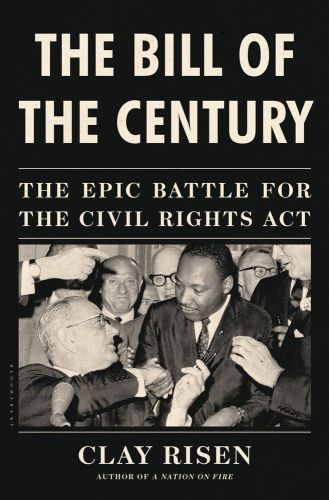
The Bill of the Century
The Epic Battle for the Civil Rights Act
کتاب های مرتبط
- اطلاعات
- نقد و بررسی
- دیدگاه کاربران
نقد و بررسی

February 10, 2014
On the 50th anniversary of the passing of the landmark Civil Rights Act, New York Times staff editor Risen (A Nation on Fire) takes an approach comparable to other similarly timed books on the subject: President Kennedy proposed the drafting of the bill; Lyndon Johnson, as Kennedy’s successor, dogged Congress to pass it; and Martin Luther King, Jr. kept civil rights movement participants focused on it. Risen’s interest is less in these big names than in the “pluralism of the process”—the actions of a variety of politicians and other policy makers who ultimately shaped and shepherded the legislation through Congress. He opens with an overview of the postwar civil rights movement, contextualizing Kennedy’s nationally televised June 11, 1963, exhortation to Congress to craft a sweeping equal rights bill. From there, it took just over a year of negotiations and compromises, both inside and outside of Congress, for the bill to become law. Risen does his best to infuse drama into a story that is already a matter of the historical record. Fortunately, Risen is adept at weaving in juicy snippets of conversation
and his fluid prose mutes some of the wonkiness in the political-process narrative. Illus.

February 15, 2014
A journalist's in-depth, behind-the-scenes account of the unsung congressional and White House heroes who helped the Civil Rights Act become the law of the land. Segregation and discrimination were legal in the United States until 1964, when Congress passed the Civil Rights Act. Hailed as a landmark piece of legislation, the new law "reached deep into the social fabric of the nation to refashion structures of racial order and domination that had held for almost a century." Historians generally credit Martin Luther King Jr. and Lyndon B. Johnson with playing the roles key to the passage of this Kennedy administration brainchild. New York Times op-ed editor Risen (A Nation of Fire: America in the Wake of the King Assassination, 2009) argues that this view of how the act became law "distorts not only the history of the act but the process of American legislative policymaking in general." He shows instead that the act, which emerged in response to the racial unrest and conflicts of the early 1960s, developed through a fraught push-pull process involving endless filibustering on one hand and intensive lobbying efforts and back-room deal making on the other. Risen also analyzes the tense relationships between liberal Northern Democrats and conservative Southern ones, many of whom had begun leaning toward the Republican Party due to its emphasis on states' rights. As Johnson realized, a win for the Civil Rights Act would mean a loss of an entire voting block in future elections. Many Republicans, like senators Barry Goldwater and John Tower, openly fought against this legislation. But an invisible and all-important few, like Senate Minority Leader Everett Dirksen, became instrumental in ensuring the bill's survival in Congress. Risen's attention to the many minor characters in this historical saga is both a strength and weakness. It makes for scrupulous accuracy but also slow, labyrinthine reading. Well-researched but sometimes tedious.
COPYRIGHT(2014) Kirkus Reviews, ALL RIGHTS RESERVED.

March 1, 2014
Unlike Purdum (see above review), Risen (staff editor, New York Times; A Nation on Fire: America in the Wake of the King Assassination) claims the Civil Rights Act (1964) alone as the most important piece of legislation of the last century. Both Risen and Purdum present excellent, nuanced accounts, agreeing that Presidents Kennedy and Johnson played lesser roles than did several legislators and the accelerating Civil Rights movement itself. Arguably, Risen's most important contribution is revealing that J. Irwin Miller and the National Council of Churches--tireless lay and ministerial advocates--served as the act's moral conscience, and that it likely would not have passed without the resulting groundswell of public support. Risen adds deputy U.S. Attorney General Nicholas Katzenbach to the roster of unsung heroes. He views Richard Russell and his bloc of Southern Democratic senators as the "true masters of the Senate." Interestingly, the author concludes that the act did not create the Republican South but rather catalyzed a long-term conservative trend begun in the 1950s. VERDICT The story of the Civil Rights Act is well served by both of these books, but Purdum's portrayals of those who supported or opposed it tend to be more detailed.--Karl Helicher, Upper Merion Twp. Lib., King of Prussia, PA
Copyright 2014 Library Journal, LLC Used with permission.

























دیدگاه کاربران